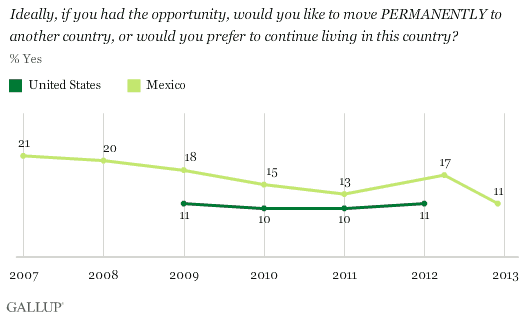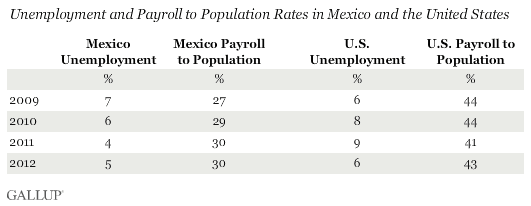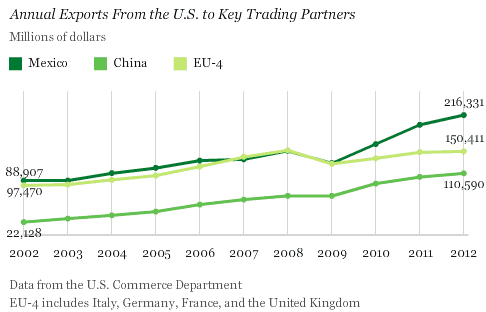PRINCETON, NJ -- As lawmakers in the United States ponder the shape and form of comprehensive immigration reform, residents of Mexico -- the country that has been the largest source of U.S.-bound immigration over the past decade -- are no more likely than U.S. residents are to express a desire to leave their home country. Eleven percent of Mexicans say they would leave their homeland if given the opportunity -- a decline of about half from 21% in 2007. Likewise, the 11% of Americans who would migrate has changed little over the past four years.

The U.S. has long prided itself on its ability to attract rather than lose residents, and some have seen Mexico as the main hub for U.S.-bound immigration. The Gallup data call into question these long-held assumptions because as many Mexicans would leave Mexico as Americans would leave America.
The percentage of Mexicans willing to leave Mexico changed significantly over 2012. In December 2012, Mexico's desire to migrate statistic was 11% -- identical to that of the U.S. An earlier survey in May 2012, conducted during a presidential campaign that reportedly stoked popular anxieties as to the future direction of the country, found the percentage at a higher 17%, a result that may be a one-time anomaly. Overall, for 2012, an average of 14% of Mexicans said they would leave their country, a result that is not statistically significant when compared with the 11% of U.S. residents that would leave if given the opportunity.
Among those Mexicans with an inclination to leave, few have actual plans to do so in the next 12 months. Again, there is a large discrepancy between the surveys conducted in April and December of 2012: In April, 21% of those with a desire to migrate planned to leave in the next 12 months, while in December, 4% had designs on leaving in the coming year. Nonetheless, for many would-be migrants, leaving Mexico is not an immediate priority. Of those Americans who would leave if given the opportunity, less than 1% say they plan to leave in the next 12 months.
These findings come from 2012 Gallup World Poll surveys conducted in the U.S. and Mexico. This convergence of the desire to migrate statistic between the U.S. and Mexico comes at a time when the U.S. is considering major changes to its immigration laws. Mexican-born immigrants make up the largest immigrant group in the U.S., so studying their desire to migrate may provide some early indicators of future migrant flows into America.
Mexico Enjoys Low Unemployment, Increased Trade With U.S.
Mexico's new president, Enrique Pena Nieto, recently said that the Mexican government "will work to improve the quality of life and opportunities in Mexico so that migration is a personal decision and not a necessity." In many ways, this is already a reality. Propitious economic conditions are allowing Mexicans to find work in their own country. Unemployment is low, at 6% in 2012, according to Gallup data. The official unemployment rate for 2012 according to average monthly unemployment rates was 5%. Meanwhile, Mexico's economy has rapidly expanded, averaging approximately 4% GDP growth over the last three years, compared with 2% growth in the U.S. over the same period. In December 2012, 13% of Mexicans described their national economy as "poor," the lowest amount in the four-year history of the question, far fewer than said the same in the U.S.

Economic progress notwithstanding, Mexico still lags behind the U.S. in the Payroll to Population (P2P) employment rate that is highly correlated with a country's well-being and GDP per capita. If the strengthening economy can produce a higher P2P for Mexico in the future, Mexicans may become even less likely to want to migrate.
As migration desires in Mexico appear to stabilize, the U.S. and Mexico economies are increasingly intertwined. Indeed, Mexico is fast becoming one of the largest consumers of U.S. exports valued in dollars, growing 12% annually over the past decade. Mexico buys more goods and services from the U.S. than China and, since 2009, more than the four largest economies of the European Union -- Germany, France, the United Kingdom, and Italy -- combined.

Implications
As the U.S. Congress considers sweeping changes to the immigration system, Mexicans are no more likely than Americans are to wish to leave their country. This may allow for a calmer, less acrimonious immigration debate in the U.S. than would otherwise occur if throngs of Mexicans were attempting to enter the U.S. Of course, a substantial number of Mexicans, as well as peoples from all types of nationalities, still hope to come to the U.S., forcing the need for immigration reform. Moreover, the percentage of the U.S. Mexican population has been steadily declining. The healthy Mexican economy, especially compared with the U.S. economy's less-than-stellar performance, may be one reason many Mexicans have decided to stay home.
Hosting Mexico's President Pena Nieto in late November 2012, President Barack Obama commented on "the extraordinarily close relationship" between the U.S. and Mexico, but in times past, the relationship has seemed distant. Indeed, it can be argued that Mexico has something of an image problem with many Americans, as about one in two Americans have a mostly or very negative opinion (49%) of their southern neighbor. By comparison, 91% of Americans have positive feelings about Canada, the other country that borders the continental United States.
Mexico has provided the greatest share of new U.S. immigrants in the past 10 years compared with any other country, according to Homeland Security, and this fact has probably had a role in shaping Americans' negative feelings about Mexico. Yet, in light of these data, it is feasible that Americans may someday soon revise their assessments of Mexico. Mexico is prospering economically, with a workforce that increasingly wishes to remain within its own borders. In turn, Mexico is becoming a leading market for U.S. exports. Should all of these trends continue -- the growing Mexican economy; widening trade ties between the U.S. and Mexico; and a stable, low desire to migrate percentage in Mexico -- residents of the U.S. and Mexico may come to see each other as neighbors, trading partners and, indeed, friends.
For complete data sets or custom research from the more than 150 countries Gallup continually surveys, please contact us.
Survey Methods
Results are based on face-to-face interviews with about 1,000 adults, aged 15 and older. Surveys were conducted in November 2005, July 2007, July 2008, July 2009, July 2010, October 2011, April 2012, and December 2012 in Mexico. In the United States, surveys were conducted in July 2006, August 2007, June 2008, May 2009, July 2010, June 2011, January 2012, and June 2012.
For results based on the total sample of national adults, one can say with 95% confidence that the maximum margin of error ranges from ±3.4 to ±4.1 percentage points. Results presented by subgroup would have a higher margin of error. The margin of error reflects the influence of data weighting. In addition to sampling error, question wording and practical difficulties in conducting surveys can introduce error or bias into the findings of public opinion polls.
For more complete methodology and specific survey dates, please review Gallup's Country Data Set details.
